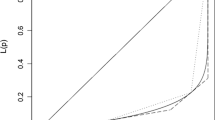Abstract
The purpose of this paper is to justify the use of the Gini coefficient and two close relatives for summarizing the basic information of inequality in distributions of income. To this end we employ a specific transformation of the Lorenz curve, the scaled conditional mean curve, rather than the Lorenz curve as the basic formal representation of inequality in distributions of income. The scaled conditional mean curve is shown to possess several attractive properties as an alternative interpretation of the information content of the Lorenz curve and furthermore proves to yield essential information on polarization in the population. The paper also provides asymptotic distribution results for the empirical scaled conditional mean curve and the related family of empirical measures of inequality.
Similar content being viewed by others
References
Aaberge, R.: Om måling av ulikskap, Rapporter 82/9, Statistisk sentralbyrå (In Norwegian) (1982)
Aaberge, R.: Characterizations of Lorenz curves and income distributions. Soc. Choice Welf. 17, 639–653 (2000)
Aaberge, R.: Axiomatic characterization of the Gini coefficient and Lorenz curve orderings. J. Econ. Theory 101, 115–132 (2001)
Aaberge, R.: Ranking Intersecting Lorenz Curves, CEIS Tor Vergata Research Paper Series, Discussion Paper No. 45 (2004)
Aaberge, R.: Asymptotic distribution theory of empirical rank-dependent measures of inequality. In: V. Nair (ed.), Advances in Statistical Modeling and Inference – Essays in Honor of Kjell A. Doksum, World Scientific, 2006 (2006)
Aaberge, R., Colombino, U., Strøm, S.: Do more equal slices shrink the cake?: An empirical evaluation of tax-transfer reform proposals in Italy. J. Popul. Econ. 17, 767–785 (2004)
An, M.Y.: Logconcavity versus logconvexity: a complete characterization. J. Econ. Theory 80, 350–369 (1998)
Atkinson, A.B.: On the measurement of inequality. J. Econ. Theory 2, 244–263 (1970)
Atkinson, A.B., Bourguignon, F.: The design of direct taxation and family benefits. J. Public Econ. 41, 3–29 (1989)
Ben Porath, E., Gilboa, I.: Linear measures, the Gini index, and the income-equality trade-off. J. Econ. Theory 64, 443–467 (1994)
Billingsley, P.: Convergence of Probability Measures. Wiley, New York (1968)
Bonferroni, C.: Elementi di Statistica Generale. Seeber, Firenze (1930)
Bossert, W.: An approximation of the single-series Ginis. J. Econ. Theory 50, 82–92 (1990)
Caplin, A., Nalebuff, B.: Aggregation and social choice: a mean voter theorem. Econometrica 59, 1–23 (1991)
Chakravarty, S.R., Muliere, P.: Welfare indicators: a review and new perspectives. Metron 61, 1–41 (2003)
Chotikapanich, D., Griffiths, W.: On calculation of the extended Gini coefficient. Rev. Income Wealth, 47, 541–547 (2001)
D’Addario, R.: Curve di Concentrazione, Elasticitá, Flessibilitá, Densitá Media e Densitá Marginale dei Redditi. Cressati, Bari (1936)
Donaldson, D., Weymark, J.A.: A single parameter generalization of the Gini indices of inequality. J. Econ. Theory 22, 67–86 (1980)
Donaldson, D., Weymark, J.A.: Ethically flexible indices for income distributions in the continuum. J. Econ. Theory 29, 353–358 (1983)
Eltetö, Ö., Frigyes, E.: New inequality measures as efficient tools for causal analysis and planning. Econometrica 36, 383–396 (1968)
Esteban, J.M., Ray, D.: On the measurement of polarization. Econometrica 62, 819–851 (1994)
Fields, G.E., Fei, J.C.H.: On inequality comparisons. Econometrica 46, 303–316 (1978)
Fjærli, E., Aaberge R.: Tax reforms, dividend policy and trends in income inequality: empirical evidence based on Norwegian data, Discussion Paper No. 284, Statistics Norway (2000)
Giorgi, G.M.: A methodological survey of recent studies for the measurement of inequality of economic welfare carried out by some Italian statisticians. Econ. Notes 13, 145–157 (1984)
Giorgi, G.M.: Bibliographic portrait of the Gini concentration ratio. Metron 48, 183–221 (1990)
Giorgi, G.M.: Concentration index, Bonferroni; in Encyclopedia of Statistical Sciences. Update 2, 141–146 (1998)
Goldie, C.M.: Convergence theorems for empirical Lorenz curves and their inverses. Adv. Appl. Probab. 9, 765–791 (1977)
Hardy, G.H., Littlewood, J.E., Polya, G.: Inequalities. Cambridge University Press, Cambridge, UK (1934)
Heckman, J.J., Honoré, B.: The empirical content of the Roy model. Econometrica 58, 1121–1150 (1990)
Hey, J.D., Lambert, P.J.: Relative deprivation and the Gini coefficient: comment. Q. J. Econ. 94, 567–573 (1980)
Hoeffding, W.: A class of statistics with asymptotically normal distribution. Ann. Math. Stat. 19, 293–325 (1948)
Kolm, S.C.: The optimal production of social justice. In: Margolis, J., Guitton, H. (eds.) Public Economics. Macmillan, New York/London (1969)
Kolm, S.C.: Unequal inequalities I. J. Econ. Theory 12, 416–442 (1976)
Kolm, S.C.: Unequal inequalities II. J. Econ. Theory 13, 82–111 (1976)
Mehran, F.: Linear measures of inequality. Econometrica 44, 805–809 (1976)
Nygård, F., Sandström A.: Measuring Income Inequality. Almqvist and Wiksell International, Stockholm (1981)
Rothschild, M., Stiglitz, J.E.: Increasing risk: a definition. J. Econ. Theory 2, 225–243 (1970)
Sen, A.: Informational bases of alternative welfare approaches. J. Public Econ. 3, 387–403 (1974)
Weymark, J.: Generalized Gini inequality indices. Math. Soc. Sci. 1, 409–430 (1981)
Wolfson, M.: When inequalities diverge. Am. Econ. Rev. 84, 353–358 (1994)
Yaari, M.E.: The dual theory of choice under risk. Econometrica 55, 95–115 (1987)
Yaari, M.E.: A controversial proposal concerning inequality measurement. J. Econ. Theory 44, 381–397 (1988)
Yitzhaki, S.: On an extension of the Gini inequality index. Int. Econ. Rev. 24, 617–628 (1983)
Zoli, C.: Intersecting generalized Lorenz curves and the Gini index. Soc. Choice Welf. 16, 183–196 (1999)
Author information
Authors and Affiliations
Corresponding author
Rights and permissions
About this article
Cite this article
Aaberge, R. Gini’s nuclear family. J Econ Inequal 5, 305–322 (2007). https://doi.org/10.1007/s10888-006-9050-8
Received:
Accepted:
Published:
Issue Date:
DOI: https://doi.org/10.1007/s10888-006-9050-8
Key words
- the scaled conditional mean curve
- measures of inequality
- the Gini coefficient
- the Bonferroni coefficient
- measures of social welfare
- principles of transfer sensitivity
- estimation
- asymptotic distributions



